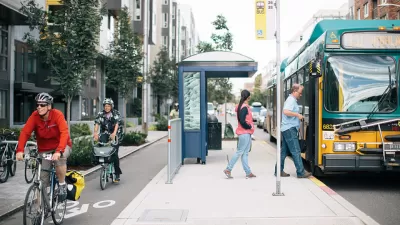Gabe Klein says cities can do a better job providing mobility by focusing on the sticks and carrots of transportation—improving transportation options and creating disincentives to driving, respectively.
“City residents also have very different mobility needs: they have reached different points in their lives, reflect different cultural backgrounds, live in neighborhoods with multiple street types and land use patterns, and take very different routes to work,” writes Gabe Klein, former head of the Chicago and Washington D.C. planning departments. Given the impossibility of a silver bullet for cities looking to solve their transportation woes, Klein argues that cities can do a better job of improving transportation by focusing efforts on “sticks” and “carrots.”
On carrots: “Did I mention that people generally don’t embrace change, particularly when it is forced upon them? This is another reason to put the options in front of people, to entice them with the cost-benefit and ease of use approach, and to let them decide what is best for them at that moment in time. This is the carrot approach.”
On sticks: “I like to ask: How can I provide a carrot that adds so much value that people don’t mind the stick? Or, put another way, how can you meld the carrot with the stick so it’s more palatable?”
FULL STORY: The Easy Way to Fix Your City's Transportation System

Planetizen Federal Action Tracker
A weekly monitor of how Trump’s orders and actions are impacting planners and planning in America.

Restaurant Patios Were a Pandemic Win — Why Were They so Hard to Keep?
Social distancing requirements and changes in travel patterns prompted cities to pilot new uses for street and sidewalk space. Then it got complicated.

Map: Where Senate Republicans Want to Sell Your Public Lands
For public land advocates, the Senate Republicans’ proposal to sell millions of acres of public land in the West is “the biggest fight of their careers.”

Maui's Vacation Rental Debate Turns Ugly
Verbal attacks, misinformation campaigns and fistfights plague a high-stakes debate to convert thousands of vacation rentals into long-term housing.

San Francisco Suspends Traffic Calming Amidst Record Deaths
Citing “a challenging fiscal landscape,” the city will cease the program on the heels of 42 traffic deaths, including 24 pedestrians.

California Homeless Arrests, Citations Spike After Ruling
An investigation reveals that anti-homeless actions increased up to 500% after Grants Pass v. Johnson — even in cities claiming no policy change.
Urban Design for Planners 1: Software Tools
This six-course series explores essential urban design concepts using open source software and equips planners with the tools they need to participate fully in the urban design process.
Planning for Universal Design
Learn the tools for implementing Universal Design in planning regulations.
Heyer Gruel & Associates PA
JM Goldson LLC
Custer County Colorado
City of Camden Redevelopment Agency
City of Astoria
Transportation Research & Education Center (TREC) at Portland State University
Camden Redevelopment Agency
City of Claremont
Municipality of Princeton (NJ)




























